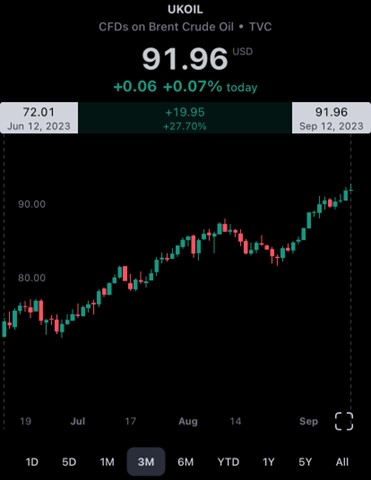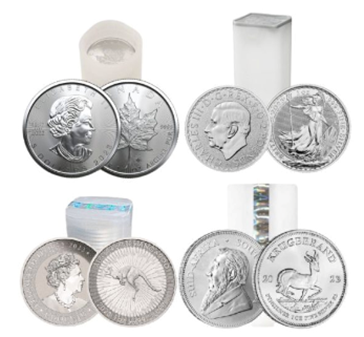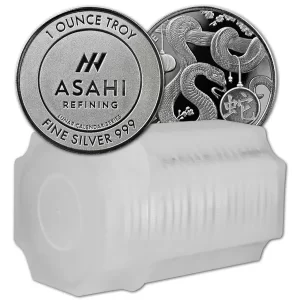Oil Price Surge & Major Pressure on Inflation
Ever since central banks began hiking rates at a record pace to combat record inflation caused by the 2020 lockdowns, all we have heard is how inflation is now under control and that the head of these central banks (mainly the Federal Reserve and Jerome Powell) are confident that inflation will return to manageable levels. However, as we have pointed out in previous newsletters – inflation often does not surge upward, only to dissipate and return to normal. In reality, inflation often moves in waves of three, with each new wave presenting higher inflation than the previous wave, this being confirmed by data from both the 1930-40s, as well as the 1970-80s that was presented in our newsletter a couple months back. That said, with the first wave of inflation seen between 2020-2022 setting 40-year records dating back to the 1970-80s, it is safe to predict that the second and third waves of inflation heading our way will blow away inflation numbers seen by Western countries in the past.
One major indicator that the second wave of inflation may be approaching quickly is the price of oil due to that contributing to the overall price of energy within the Consumer Price Index (CPI) calculation used to measure inflation. Take a look at the two pictures below, the first highlighting how the waves of inflation can be seen through the price of oil, with the second highlighting the SURGE in oil prices we saw during the first wave of inflation between 2020-2022 alone.
Looking at the first picture closely, you can see that oil surged during the first wave of inflation, only to begin pulling back as it prepared for the second wave of inflation to approach. One thing that is important to highlight, is even though we saw a pullback in oil price, similar to inflation slowly coming down, it never returned to the price pre first wave, meaning even though inflation came down, citizens still had to become accustomed to higher prices than we ever saw before 2020.
Now turning our attention to the sheer gains oil made during the first wave of inflation in the second picture, you can see that oil played a MAJOR role in inflation reaching 40-year record highs appreciating to the tune of 347.65% between 2020-2022. Also, when looking at the period after oil began to pull back in price, it appears to be preparing for another monumental run, which will force inflation even higher during the second wave. In the picture below, you can see what oil has been doing the last 3 months, during a period the public is being told inflation numbers are under control:
After pulling back for a little over a year, oil now seems to be waking back up, posting a price increase of 27.70% in the last 3 months, again, during a time when inflation is supposed to be coming down according to central banks.
When turning our attention to gold and silver, while there is not a direct correlation between the price of oil and precious metals, one thing that we can be certain of, is that the price of oil contributes to overall inflation, while gold and silver react to inflation rates, so while not directly connected, oil can without a doubt indicate the future direction of gold and silver after a period of lag. This lag is because historically, gold and silver do not react immediately to high inflation, rather they wait to confirm it has become entrenched, and once they have, they begin to account for the loss in purchasing power seen in national fiat currencies, which is another way of saying rapid currency creation leading to high inflation.
Looking over the past 5 years, according to the Bank of Canada we have seen a loss in purchasing power of 17.72%, meaning $100 of groceries in 2018, now cost $117.72 on average, and while many would argue that number is far too low as we have seen prices of everyday goods skyrocket, silver and gold over that same period have more than made up for that loss of value in the Canadian Dollar. Emphasizing the importance of becoming your own bank and holding your savings in physical gold and silver, rather than holding Canadian Dollars over the long-term. This is because you can guarantee that the Bank of Canada will always print more Canadian Dollars each year, also guaranteeing that you will continue to lose value in savings held in paper cash or digital dollars in your bank account. When looking at the two pictures below, you can see that even if the 17.72% loss of purchasing power over the last 5 years is understated, gold and silver have more than protected those that have been holding these metals.
Since 2018, gold has gone up $710.95 USD representing an increase of 59.20%, while silver has increased in price $8.37 USD representing a similar increase of 57.66%, both well over the 17.72% loss in purchasing power seen in the Canadian Dollar. To add to this, between 2020-22 during the first wave of inflation, gold appreciated 22.96%, where as silver appreciated a whopping 77.58%. Since then silver has taken a slight dip, and gold has continued on a steady climb, this is because silver is a far more volatile metal due to being heavily used as an industrial commodity. However, what this also shows is that when inflation really begins to rise, due to silver’s volatility, it often well out paces the gains seen in gold, which will likely be true once the second wave of inflation begins to rear its’ ugly head.
If you also see the writing on the wall regarding a second wave of inflation approaching, which if history is correct, will be far worse than the first wave we saw between 2020-2022, there is no time to wait when protecting the wealth you have rightfully earned. As you saw above, when gold and silver decide to move, they move QUICK, meaning the time to secure these precious assets is when prices have pulled back as they have over the last year.
 Hi,
Hi,


























